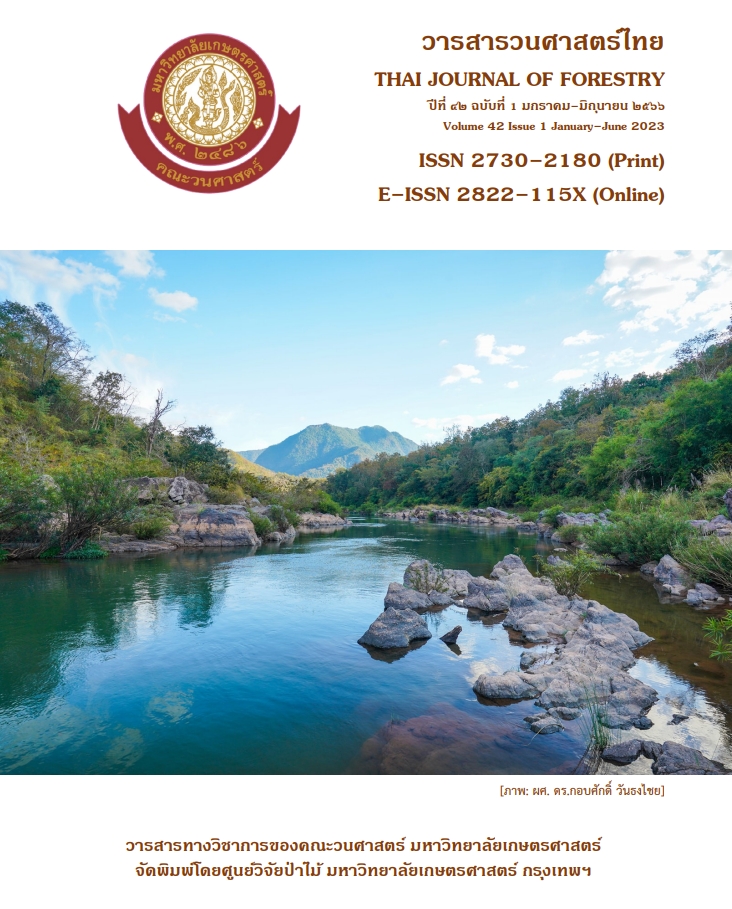Marketing of Agarwood (Aquilaria spp.) Products in Bangkok
Main Article Content
Abstract
The objectives of this research were to analyze the production, marketing, environmental value of the agarwood product business using the SWOT analysis and the five competitive force analysis of the agarwood businesses in Bangkok. Data collected through questionnaires were summarized using various statistical indicators such as frequency, percentage, mean, minimum, and maximum.
The results of this study inidcated that there were 24 agarwood businesses selling agarwood products. The products were 1) agarwood chip, priced in a range of 5,000–42,000 Baht per kilogram, 2) agarwood oil, priced in a range of 700–4,500 Baht per tora, 3) agarwood perfume sold in bottles of size 10 or 50 milliliter and priced in a range of 200–550 Baht per smaller sized bottles and 1,200 Baht per bigger sized bottles and 4) agarwood incense, priced in a range of 200–500 Baht per wrap or box. The production problems were generally related to the quality of raw materials, government regulations, availability of labor, and personnel. Marketing through advertising, selling promotional activities, staff selling and booths at trade shows were the primary methods of spreading the information about the products. The market structure was oligopoly, with the products having different quality, price, size, type, and services. The operational strategies employed in the agarwood products business were the good products strategy, siege strategy, flank attack strategy, multiple-products strategy, mobile defense strategy, and enterprise strengthening strategy. The five competitive force analyses found that the competitors in this business were competition for the market share. New entrepreneurs had difficulty entering this business. As the raw material price was set by the seller, due to the economic slowdown, buyers had higher bargaining power. Therefore, entrepreneurs should study consumer behavior, including focusing on public relations while developing new products.
Downloads
Article Details

This work is licensed under a Creative Commons Attribution-NonCommercial-NoDerivatives 4.0 International License.
ข้าพเจ้าและผู้เขียนร่วม (ถ้ามี) ขอรับรองว่า ต้นฉบับที่เสนอมานี้ยังไม่เคยได้รับการตีพิมพ์และไม่ได้อยู่ในระหว่างกระบวนการพิจารณาตีพิมพ์ลงในวารสารหรือสิ่งตีพิมพ์อื่นใด ข้าพเจ้าและผู้เขียนร่วม (ถ้ามี) ยอมรับหลักเกณฑ์และเงื่อนไขการพิจารณาต้นฉบับ ทั้งยินยอมให้กองบรรณาธิการมีสิทธิ์พิจารณาและตรวจแก้ต้นฉบับได้ตามที่เห็นสมควร พร้อมนี้ขอมอบลิขสิทธิ์ผลงานที่ได้รับการตีพิมพ์ให้แก่วารสารวนศาสตร์ คณะวนศาสตร์ มหาวิทยาลัยเกษตรศาสตร์ กรณีมีการฟ้องร้องเรื่องการละเมิดลิขสิทธิ์เกี่ยวกับภาพ กราฟ ข้อความส่วนใดส่วนหนึ่ง หรือ ข้อคิดเห็นที่ปรากฏในผลงาน ให้เป็นความรับผิดชอบของข้าพเจ้าและผู้เขียนร่วม (ถ้ามี) แต่เพียงฝ่ายเดียว และหากข้าพเจ้าและผู้เขียนร่วม (ถ้ามี) ประสงค์ถอนบทความในระหว่างกระบวนการพิจารณาของทางวารสาร ข้าพเจ้าและผู้เขียนร่วม (ถ้ามี) ยินดีรับผิดชอบค่าใช้จ่ายทั้งหมดที่เกิดขึ้นในกระบวนการพิจารณาบทความนั้น”
References
Chonlapap, N., Suksard, S., Hoamuangkaew, W., Jarusombuti, S. 2003. An analysis of marketing system of medium density fiberboard industry in Thailand. Thai Journal of Forestry, 22: 16–28. (in Thai)
Department of International Trade Promotion. 2018. Cambodia, Land of Precious Wood, Agarwood. https://www.ditp.go.th/ditp_web61/article_sub_view, 26 February 2020. (in Thai)
Kotler, P. 2000. Marketing Management. The Millennium Edition. Prentice Hall Inc, New Jersey, USA.
Nammakuna, C., Suksard, S., Hoamuangkaew, W. 2009. Production and marketing of bamboo products in Lampang province. Thai Journal of Forestry, 28(2): 39 - 47. (in Thai)
Royal Forest Department. 2020. Forests Product Trade License. Timber Forests Product and Chainsaw Permission Division. Permission Office, Bangkok, Thailand. (in Thai)
Siripatanadilok, S. 2007. Agarwood species and trade. Journal of Forest Management, 1(2): 19 – 31. (in Thai)
Sukawanich, C. 2008. Agarwood, the King of Economic Wood. Media Relations Club, Bangkok, Thailand. (in Thai)
Vadhanasin, P., Decharin, P. 1999. Strategic Management and Business Policy. 2nd printing. Chulalongkorn University Press, Bangkok, Thailand. (in Thai)
Wijitphan, P. 2006. Agarwood, the Ten Billion Fragrant Woods. Naka Inter Media Co., LTD., Bangkok, Thailand. (in Thai)


